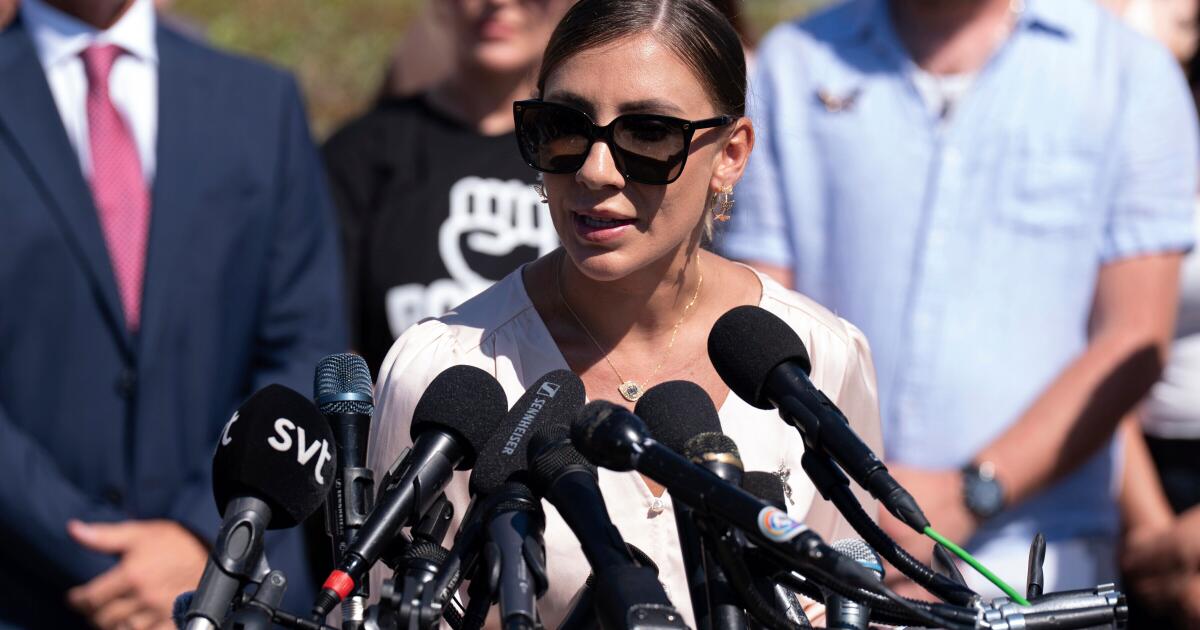Epstein’s accusers grapple with complex emotions about promised release of Justice Department files
For Marina Lacerda, the upcoming publication of U.S. government files on Jeffrey Epstein represents more than an opportunity for justice.
She says she was just 14 when Epstein started sexually abusing her at his New York mansion, but she struggles to recall much of what happened because it is such a dark period in her life.
Now, she’s hoping that the files will reveal more about the trauma that distorted so much of her adolescence.
“I feel that the government and the FBI knows more than I do, and that scares me, because it’s my life, it’s my past,” she told the Associated Press.
President Trump signed legislation last week that will force the Justice Department to release documents from its voluminous files on Epstein.
“We have waited long enough. We’ve fought long enough,” Lacerda said.
It isn’t clear yet how much new information will be in the files, gathered over two decades of investigations into Epstein’s alleged sexual abuse of many girls and women.
Some of his accusers expect the files to provide a level of transparency they had hardly allowed themselves to believe would materialize, but the release of the documents will be a more complicated moment for others.
Two federal investigations cut short
The FBI and police in Palm Beach, Fla., began investigating Epstein in the mid-2000s after several underage girls said he had paid them for sex acts. He pleaded guilty in 2008 to charges including procuring a minor for prostitution, but a secret deal with the U.S. attorney in Florida — future Trump Cabinet member Alex Acosta — allowed him to avoid a federal prosecution. He served little more than a year in custody.
Jena-Lisa Jones says she was abused by Epstein in Palm Beach in 2002, when she was 14. She did not report the abuse to the police at the time, but she later became one of many accusers to sue the multimillionaire.
The Miami Herald published a series of articles about Epstein in 2018 that exposed new details about how the federal prosecution was shelved. A year later, federal prosecutors in New York, where Epstein owned a mansion, revived the case and charged him with sex trafficking.
Jones said she was interviewed during that federal investigation and was prepared to testify in court.
“It was very important for me to have my moment, for him to see my face and hear my words, and me have that control and power back,” Jones said.
But that day never came.
Epstein killed himself in a federal jail cell in New York City in August 2019.
In lieu of her day in court, Jones and others are hoping for a public reckoning with the publication of the government files on Epstein.
While the government only ever charged two people in connection with the abuse case — Epstein and his longtime confidant Ghislaine Maxwell, who is in prison for her related crimes — at least one of Epstein’s accusers has claimed she was instructed to have sex with other rich and powerful men.
Jones didn’t make similar claims, but said she believes the documents could map out a “broad scheme” involving others.
“I’m hoping they’re shaking a little bit and that they have what’s coming for them,” Jones said.
Filling in the gaps
Lacerda, now 37, is also hoping the files will clarify her own personal experience, which is muddled by the pain she said she endured at that time in her life.
“I was just a child and it’s just trauma. That’s what trauma does to your brain,” Lacerda said.
An immigrant from Brazil, Lacerda said she was working three jobs to support herself and her family the summer before 9th grade when a friend said she could make $300 if she gave Epstein massages.
The first time she massaged Epstein, he told her to remove her shirt, she said.
Lacerda said she was soon spending so much time working for Epstein that she dropped out of school. The sexual abuse persisted until she turned 17, when Epstein informed her that she was “too old,” she said.
Lacerda wondered whether the files might include videos and photographs of her and other victims at Epstein’s properties.
“I need to know — for my healing process and for the adult in me — what I did as a child,” Lacerda said. “It will be re-traumatizing, but it’s transparency — and I need it,” she said.
Accusers wonder, why now?
For Lacerda, the elation around the upcoming release of the files gave way to familiar feelings for many women who survive abuse: fear and paranoia.
“In the heat of the moment, we were like, ‘Wow, this is like, everything that we’ve been fighting for.’ And then we had to take a moment and be like, ‘Wait a minute. Why is he releasing the files all of a sudden?’ ” Lacerda said.
The abrupt change in the political momentum made her uneasy. She wondered whether the documents would be doctored or redacted to protect people connected to Epstein.
Others echoed her concerns, and wondered if the government would sufficiently protect victims who have remained anonymous, who fear scrutiny and harassment if their names were to become public.
“For the rest of my life, I will never truly trust the government because of what they’ve done to us,” Jones said.
Haley Robson, who says she was abused by Epstein when she was 16, has the same concerns.
Robson was a leading voice in advocating for the Florida legislation signed in 2024 that unsealed the grand jury transcripts from the 2006 state case against Epstein.
She said the political maneuvering in recent months about the files led to nonstop anxiety, reminiscent of how she felt when she was abused as a teenager.
“I guess it really comes from the trauma I’ve endured, because this is kind of what Jeffrey Epstein did to us. You know, he wasn’t transparent. He played these manipulation tactics,” she said. “It’s triggering for anybody who’s been in that situation.”
Still, Robson said she is trying to savor the victory while she can.
“This is the first time since 2006 where I don’t feel like the underdog,” she said.
Riddle writes for the Associated Press.

